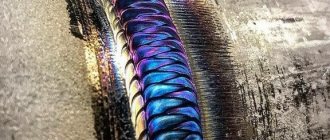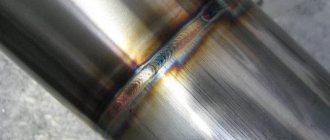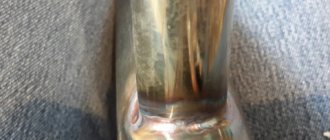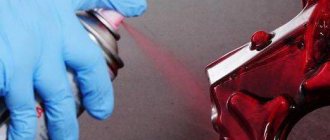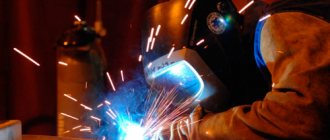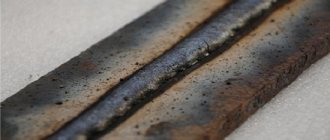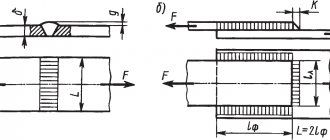Article updated and supplemented: August 08, 2021
The quality and strength of connecting seams in metal structures are no less important than the corrosion resistance of the metal itself. Welding is the fastest, most convenient and reliable way to connect two metal elements together. But non-specialists most often do not even realize that such connecting seams also need protection.
Connection points are always the weakest point of any metal structure; they determine the degree of its strength and service life. During operation, the seams bear the main load, so their safety determines the strength and durability of the entire structure.
To ensure long-term and high-quality service of any metal product, it is necessary to ensure reliable protection of welds from corrosion. Moreover, it is recommended to do this after completing the welding work without delay, since the process of destruction of the material starts almost immediately.
Causes of weld corrosion
The weld seam in any metal structure requires mandatory processing. When welding, the metal and welding wire heat up and are exposed to high temperatures. This process in itself is already the reason that provokes the onset of corrosion. In addition, the resulting seam after welding always contains local mechanical stresses, which also provoke oxidative processes. One of the causes of rust is the heterogeneity of the metals connected to each other.
Moreover, during the welding process, the coating of the protective layer is destroyed if the part was previously covered with it. As a result, the joints become the most accessible points for corrosion to penetrate into your product, especially when operating the facility outdoors.
Also, the intense oxidation process is triggered by the following factors:
- The presence of flux materials almost always remain on the metal at least to a minimal extent. In the future, any contact with water provokes the onset of the oxidation process.
- Defects in welds that occur even in the most experienced welders. In these places, moisture usually accumulates, which is a catalyst for oxidation.
- Welding spatter. Beginning welders quite often experience molten metal splashing and sticking to various surfaces. If they are not removed, the adhering drops of metal will be a serious defect upon delivery of the object.
Types of corrosion on welding seams
Solid. It can be uniform or uneven. Typically formed in carbon steels and unalloyed metals. Foci of corrosion are located over the entire surface of the seam, and accordingly, destruction occurs very quickly. Therefore, it is imperative to take measures to protect yourself.
Local. This type of rust appears as dots or spots on some areas of the weld. This corrosion occurs on X12MF steels and welds that lack chromium.
Knife. This is a thin line next to the weld and the metal itself. Passes through the entire thickness of the metal grains. In this regard, this type of corrosion is the most dangerous. It occurs mainly on high-carbon alloys, as well as on austenitic and alloy steels.
Basic protective anti-corrosion measures
Immediately after the welding site has cooled, it is necessary to carry out a procedure to treat and protect it. The main measures to protect the weld from corrosion include:
- Annealing the seam
, if technologically possible. This procedure helps to get rid of internal stress in the structure. Unfortunately, it is not always possible to carry out this procedure. - Grinding and mechanical cleaning
, with their help, adhering drops, microdefects and unnecessary inclusions are removed. This procedure eliminates a large number of irregularities and makes it possible to reduce the diameter of the seam, although this should be done with extreme caution. It must be taken into account that grinding negatively affects the overall strength of the connection. Never remove excess layers of metal unless absolutely necessary. - Surface treatment
, which can be used to remove all potential corrosion catalysts from a part. This treatment is carried out with special mixtures containing orthophosphoric acid. It helps to easily dissolve oxidation products and flux elements, simultaneously creating a special film on the metal. This is the so-called passivating layer, designed to protect metal structures from corrosive damage.
After all these measures for anti-corrosion protection of welded joints have been carried out, they can be coated with a protective compound. It is applied to a completely degreased and dry surface.
Purpose of seam sealants
Welded seams require additional protection so that the metal structure lasts longer and negative processes do not occur on the material, for example, corrosion does not appear. The purposes of sealants are as follows:
- Waterproofing layer for seams or base;
- Closing cracks and gaps;
- Repair work on planes with flaws and cracks.
The products differ in the level of shrinkage following curing. Having treated the metal with the composition, there is no need to be afraid that vibration effects will affect the integrity of the seam; the layer can stretch and bend. The product is used for pipelines, heating systems, in parts of various devices and for other items, depending on the chosen type.
When welding channels, high-quality electrodes are used. In this case, the drawings should be carried out in accordance with the ESKD, after which additional processing of the seams is also sometimes used.
Welds require additional protection to ensure that the metal structure lasts longer.
What does the magazine consist of?
The document is drawn up in the form of a cover with a title and back side, as well as an internal part. On the last page there are signatures of the persons running the journal and managers, and stamps are affixed. Each page, except the title page, is numbered. The document is stitched for convenience. The cover can be made of thicker paper.
At the very beginning, the start date of logging and the end date of its logging should be indicated. If the second date is usually entered upon completion of the journal, then until that moment it is considered to be indefinite.
On the second side of the title page the following information is filled in:
- The name of the company that performs the work.
- The name of a specific construction project.
- Position, full name and signature of the financially responsible employee who keeps the log and is responsible for the reliability of the anti-corrosion protection of the welded joints made.
- Who developed the design documentation and drawings (name of the organization and its address).
- Project code.
- If available, the name of the institution that was involved in the development of the project, design activities for this organization as a whole (information not required to be filled out).
- The company that manufactured the structures mentioned in the magazine (with address data).
- Work project code.
- Name and signature of the representative (or head) of the customer organization (if any).
- Start and end dates.
In addition to the title page, the document contains a voluminous tabular section.
It is located on each subsequent page and is filled out by two employees. One of them is the performer of the work, the second is his immediate supervisor. Attention! The table should be filled in as work progresses. Each column corresponds to one stripped and strengthened connection. If anti-corrosion protection of several connections was carried out in one work shift, then information about each is placed in a separate line.
Timely and reliable journal keeping will help the accountant with payroll, satisfy the curiosity of inspection organizations and make the execution of work a more orderly process subject to accounting.
Sealant application technology
The use of sealant for a car has certain requirements. You need to know the operating rules described below:
- First, the base must be cleaned of all types of contaminants, including removing rust and degreasing the base;
- To increase the degree of adhesion, stripping is carried out with red Scotch Brite;
- A primer solution for metal surfaces is applied when such a step is indicated in the instructions for the sealant;
- Prepare the composition, place the tube in the gun, open the tape, or prepare a brush or spatula for applying the product;
- The product is distributed at the same speed and preferably in one go, so that the seam comes out optimally even.
The excess part of the layer is removed immediately with a spatula or simply with a gloved finger. If the layer is excessively sticky, sprinkling with water will reduce the problem. The layer can be painted after the time indicated on the packaging.
The product is distributed at the same speed and preferably in one go, so that the seam comes out optimally even.
Criteria for choosing joint sealant
Various types of sealants are created for cars: for the body, pipe joints, hatches. The differences between the compositions lie in the degree of heat-resistant, elastic properties, and durability of the processing result. The most effective are considered to be professional types, which are sold in large volumes, and it is advisable to take them for auto repair shops when a lot of similar work is carried out.
For independent one-time processing of welding seams, it is advisable to purchase small tubes of 40-200 grams. If you take a similar type, then it is advisable to leave the choice on an aluminum tube; the container allows you to maintain the technical characteristics without changing the entire shelf life.
The plastic option is cheaper, then you should use a sealant if its shelf life lasts at least six months.
There are options for sealants on sale, with a provided tip, which can be used to fill welding seams and corners conveniently. Body sealant in cartridges can only be applied using a special gun.
The differences between the compositions lie in the degree of heat-resistant, elastic properties, and durability of the processing result.
Safety precautions
Cleaning of welded seams can only be done in a special form, in compliance with all safety regulations. So, when working with chemicals, protect your hands, respiratory organs, and eyes.
Note!
Such work is carried out by a specialist with education and skills, over 18 years of age.
Welded areas are protected, as these are one of the most fragile areas of any metal structure. And if they can be strengthened, it is worth making every effort to ensure that the welded structure lasts as long as possible. For this purpose, there are methods for cleaning welds described in this material.
Tsinkoshov - zinc primer for welding
Tsinkoshov
is a composition for protecting against corrosion of welds with a high (96%) zinc content, created specifically for reliable protection against corrosion of welds and joints. Reliably protects welds from 10 to 50 years, does not degrade the quality of the weld, and allows welding after application without compromising the integrity of the coating. Discounts for forges, metal structures factories and regular customers. Packaging: 1.7 kg, 5 kg, 10 kg, 38 kg. Free delivery over 50 kg.
Tsinkoshov
– a one-component zinc-rich composition recommended for coating welded joints and seams in various metal structures. Contains 96% zinc, reliably protects against corrosion of ferrous metals.
Used:
- As a stand-alone coating.
- As a primer for applying topcoats.
- For restoration and repair of previously galvanized surfaces.
- For additional protection against corrosion of welds and joints.
The main advantages of the material
- Does not degrade the quality of the weld.
- Does not interfere with welding after application.
- Provides additional protection at joints and seams after welding - where corrosion most often occurs.
- High zinc content (96%) and the most durable protection 1 layer 40 microns ~ 10 years of protection.
- Economical consumption 1 kg – 4 m2. The cost of 1 m2 is only from 75 rubles.
- Convenient application. Drying – 20 minutes. Compatible with 99% paint materials.
- Can be applied at sub-zero temperatures – down to -30°C.
Coating feature
No special equipment or special professional skills are required to apply the composition. Due to the high zinc content and a special polymer base, the coating has cathodic protection, which makes corrosion impossible. Its protective properties are superior to hot-dip galvanizing due to the higher zinc content in the film. Easily applied to welds, fits well on uneven surfaces.
Purchase Information
Call to place an order 8
or write
[email protected]
. You can also place an order through the website.
Pickup or same-day delivery:
- Moscow, st. Promyshlennaya, 11 building 4
- St. Petersburg, Yuzhnoye shosse, 37 building 2
- Kazan, st. Tekhnicheskaya, 9
- Ekaterinburg, st. Artinskaya, 22G
- Krasnodar, st. Topolinaya, 30
- Nizhny Novgorod, Okskaya Gavan, 6, office. P2
- Tula, Khaninsky proezd, 6A
Sending to other cities by transport company during the day. Payment methods: non-cash or cash upon receipt.
The product is always in stock.
Specifications
| Color | gray, matte |
| zinc | 96% |
| Single layer thickness | 40-60 microns |
| Consumption per 1 m2 at 40 microns | 220-300 gr |
| Cost 1 m2 | from 75 RUR |
| Solvent | Solvent or orthoxylene (5-10% by weight) |
| Adhesion | 1 point |
| Application at t° | from -30°С to +50°С |
| Drying time at different temperatures | from 10 to 50 min |
| Exposure between layers | 20-40 minutes |
| Density | 2500 kg/m3 |
| Impact strength | 50 cm |
| Flexural elasticity | 1 mm |
| Heat resistance (long-term, short-term) | from -60°С to +160°С |
| Viscosity | thixotropic |
Instructions for use
Preparation stages:
- Prepare the surface for application: Clean (manually or mechanically).
- Remove as much traces of scale and small “drops” as possible after welding.
- Degrease (solvent or orthoxylene).
- Give roughness.
Important points when using:
- For long-term protection and preservation of electrochemical contact, the metal surface must be clean. Nothing should interfere with the interaction between the coating and the metal.
- For better adhesion, roughen the surface as... the dry film contains 96% zinc and only 4% other additives.
- During application, stir the composition every 15-20 minutes, zinc is heavy and settles.
Tsinkoshov is not just paint, but a special composition for galvanizing, which has a longer protection period than traditional galvanizing.
Our material is capable of independently protecting metal for decades without additional enamels, thanks to a double protection system - cathodic and barrier.
What is cathodic (active) metal protection?
The zinc coating gives up its potential to the metal and begins to be consumed first. Corrosion will not appear on the surface even if the zinc coating is damaged. The protected metal does not begin to corrode until all the zinc coating is used up. This property is characteristic of all types of galvanizing; it is also called electrochemical protection.
What is barrier protection?
Barrier – mechanical isolation of metal from moisture and oxygen.
When the Zinkoshov coating oxidizes, zinc oxide is released - white. It concretes the coating and thereby enhances the barrier protection of the metal. Thus, double (cathodic and barrier) protection against corrosion is achieved and, as a result, reliable protection for decades.
Questions about material selection? — Our technologists will select or advise correctly
Telephone:
(Free in Russia) E-mail:
[email protected]
We work from Mon-Fri (without lunch) from 08:45 to 18:00 Moscow time.
Source: https://zincor-lkm.ru/product/zinkoshov_dlya_zashity_svarki/
What do we offer
The AKRUS® trademark develops and selects protective compounds for individual orders with the required properties. We also have ready-made formulations suitable for even the most extreme operating conditions. We offer professional application of anti-corrosion coatings using specialized equipment, in full compliance with GOST paint and varnish standards and customer wishes.
Our specialists accompany all the necessary stages of work - from inspecting the objects being processed and their preparation to applying primers, finishing coatings and quality control of work.
Types of heat treatment
Types of heat treatment of welds differ in their purpose. Experts distinguish the following processes:
- Rest. The structure is brought to 300 °C and kept for one and a half to two hours. Reduces mechanical stress and reduces the hydrogen content in the weld material.
- Vacation. Consists of heating up to 700 °C and holding for three hours. Almost completely relieves stress and makes it possible to increase plasticity.
- Normalization. The entire structure, including the seam, is heated to 800 °C and held for 30-40 minutes. Allows you to achieve uniformity and fine-grained metal structure. Used on products of small thickness.
- Austenization. The product is heated to 1100 °C and held for 120 minutes. Cooling is carried out at room temperature. Increases the ductility of high-alloy alloys by transforming their crystal structure.
- Annealing. Heating to 960 °C, holding for three hours and cooling at room temperature. Used for high alloy alloys to improve corrosion resistance.
Induction tempering of the weld
Preparing pipes for weld normalization
As a rule, the welded joint is cleaned before heat treatment.


